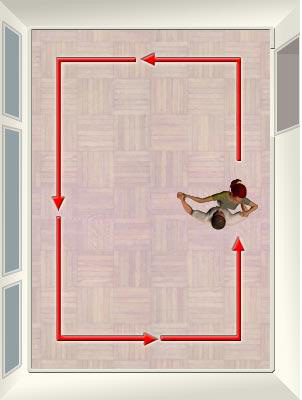Most active topic starters
| pro | ||||
| Admin | ||||
| passiondance | ||||
| lijingjunFA | ||||
| jindance | ||||
| trungkienfa | ||||
| danceshare | ||||
| dancesport2010 | ||||
| shine | ||||
| socklbls |
Top posting users this month
| No user |
The Line of Dance
Trang 1 trong tổng số 1 trang
 The Line of Dance
The Line of Dance
The Line of Dance
The Line of
Dance is an imaginary line which represents the counterclockwise flow of traffic around the dance floor. During traveling dances such as Waltz and Tango, all dancers will move in the same general counterclockwise direction, in order to minimize collisions.
Spot vs. Progressive
Every dance style from Tango to Cha Cha can be categorized as either a Spot Dance or a Progressive Dance. Spot dances are characterized by movements which cause the dancers to remain in one general area of the floor throughout the dance, whereas Progressive dances contain movements that cause dancers to travel continuously. The Line of Dance only applies to the latter category.
* Note that all ballroom dances are classified as progressive dances, while most Latin dances are classified as spot dances. The two exceptions to this are Samba and Paso Doble, which have the distinction of being the only Latin dances that travel around the line of dance.
As you can see in the illustration, the line of dance is more of a rectangle than a circle (This is no accident, as most rooms are rectangular). This divides the line of dance into two distinct areas: (1) Sides, and (2) Corners. When dancing at the side of the room, you will travel along the line of dance toward the corner. When the corner is reached, you turn the corner and begin moving down the "new" line of dance.
Even during the progressive dances, not all movements will travel exactly along the Line of Dance. Some movements can travel across it, weave in and out, or even move against it for a short period of time. But the overall movement should continue to progress in the direction of the Line of Dance. The amount of wiggle room
afforded to each dancer is dependent upon many factors, including the floor size, number of dancers on the floor, the dance, and the environment (e.g. social dancing, competition, showcase, etc).
As a general rule, it is best to use the sides of the room to travel. The corners give you move flexibility to turn and change direction, since everybody does the same here. Stationary figures, lines, and poses should be reserved for the center of the room, where the flow of traffic is less pronounced.
The Line of
Dance is an imaginary line which represents the counterclockwise flow of traffic around the dance floor. During traveling dances such as Waltz and Tango, all dancers will move in the same general counterclockwise direction, in order to minimize collisions.
(Fig.1) The Line of Dance


Spot vs. Progressive
Every dance style from Tango to Cha Cha can be categorized as either a Spot Dance or a Progressive Dance. Spot dances are characterized by movements which cause the dancers to remain in one general area of the floor throughout the dance, whereas Progressive dances contain movements that cause dancers to travel continuously. The Line of Dance only applies to the latter category.
| SPOT DANCES (no line of dance) | PROGRESSIVE DANCES (travel along line of dance) |
| Cha Cha Rumba Bolero Swing/Jive Mambo/Salsa Merengue | Waltz Tango Viennese Waltz Foxtrot Quickstep Samba* Paso Doble* |
* Note that all ballroom dances are classified as progressive dances, while most Latin dances are classified as spot dances. The two exceptions to this are Samba and Paso Doble, which have the distinction of being the only Latin dances that travel around the line of dance.
Movement
Around L.O.D.
Around L.O.D.
As you can see in the illustration, the line of dance is more of a rectangle than a circle (This is no accident, as most rooms are rectangular). This divides the line of dance into two distinct areas: (1) Sides, and (2) Corners. When dancing at the side of the room, you will travel along the line of dance toward the corner. When the corner is reached, you turn the corner and begin moving down the "new" line of dance.
Even during the progressive dances, not all movements will travel exactly along the Line of Dance. Some movements can travel across it, weave in and out, or even move against it for a short period of time. But the overall movement should continue to progress in the direction of the Line of Dance. The amount of wiggle room
afforded to each dancer is dependent upon many factors, including the floor size, number of dancers on the floor, the dance, and the environment (e.g. social dancing, competition, showcase, etc).
As a general rule, it is best to use the sides of the room to travel. The corners give you move flexibility to turn and change direction, since everybody does the same here. Stationary figures, lines, and poses should be reserved for the center of the room, where the flow of traffic is less pronounced.
Trang 1 trong tổng số 1 trang
Permissions in this forum:
Bạn không có quyền trả lời bài viết
 Trang Chính
Trang Chính
» LỊCH HỌC MỚI NĂM 2013
» Ảnh viện cho bé Suri Stuido – Nơi lưu giữ tuổi thơ của mẹ & bé
» Cùng cảm nhận không gian và dịch vụ với Viện thẩm mỹ Âu Việt.
» Thanh Phuc
» Riccardo Cocchi & Yulia Zagoruychenko - Rumba basic
» Yulia & Riccardo Cha cha
» Màn biểu diễn ấn tượng - có 1 không 2 tại cuộc thi America got talent
» ĐIỀU LỆ GIẢI KVTT CNVC - LĐ VÀ THANH NIÊN QUẬN 1